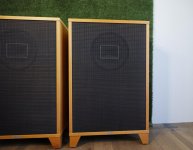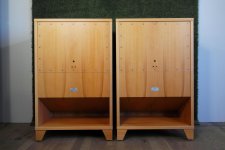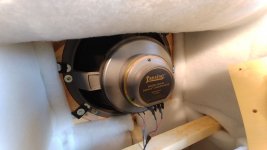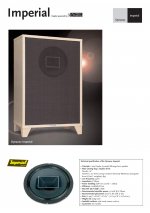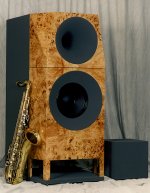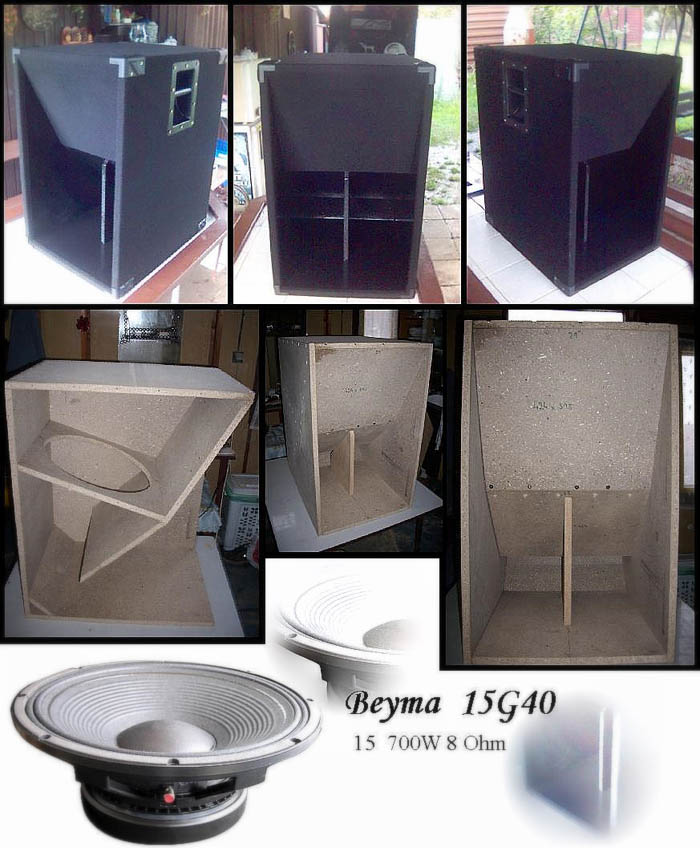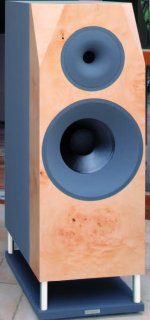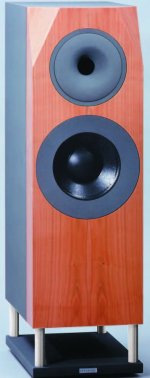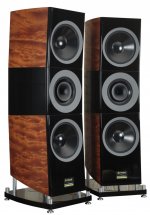No, I won't dive deeply into Altec's Duplex range, that would require a separate thread.
The 604 represents the bridge between my previous and next posts.
The 604 represents the bridge between my previous and next posts.
Attachments
Last edited:
Xo by ear. Coax enclosure about 70L. I may open a seperate thread to help improve the config. Here are couple of photos of the speaker build. I got distracted with other things and left them unfinished. Only recently decided to get back to them after few years.
It would definitely be wise to measure the Response outside in order to properly set up the crossover and frequency response correction.
70 liters closed-box is rather large for this woofer when used as a low-mid.
The build qualitiy is nice. But with this choice of drivers you would have the chance to build a "real" D'appolito by mounting them as close as possible. Keep in mind that this will be even more important as soon as you use a horn instead of the coax which makes using an even higher crossover necessary.
Leaving such large boxes unfinished is not a bad thing as long as the x-over is not fully sorted out because you might have to schlepp them inside and out a few times in order to measure and tune them.
Regards
Charles
Last edited:
What do you guys think about the new 1.4" Celestion cdx14-3040? Looks like it could do both decent midrange and top octave?
1.4-inch exit neodymium magnet compression driver
Undoubtedly a good driver, developed by the same people that were responsible for the Axi2050.
Response looks clean up to 15kHz.
It would definitely be wise to measure the Response outside in order to properly set up the crossover and frequency response correction.
70 liters closed-box is rather large for this woofer when used as a low-mid.
The build qualitiy is nice. But with this choice of drivers you would have the chance to build a "real" D'appolito by mounting them as close as possible. Keep in mind that this will be even more important as soon as you use a horn instead of the coax which makes using an even higher crossover necessary.
Leaving such large boxes unfinished is not a bad thing as long as the x-over is not fully sorted out because you might have to schlepp them inside and out a few times in order to measure and tune them.
Regards
Charles
Drivers are indeed wide apart, which would probably result in lobing issues.
tuyen may consider replacing the baffle.
70L is quite big, but a quick sim revealed no issues. However, I would use this driver in a BR configuration.
The 15G40 is a typical PA woofer. It won't go very low, no matter the type or size of cab it's mounted in. It does play quite loud though.
It's true, the Faital 15PR400 or PH500 are much better suited for midwoofer duties and could also be used without subs.
Last edited:
Well that doesn't sound like lacking LF extension of the 15G40:
Augspurger Duo 15-SXE3/2500 – Augspurger
But that is of course only possible with the use of EQ.
Regards
Charles
Augspurger Duo 15-SXE3/2500 – Augspurger
But that is of course only possible with the use of EQ.
Regards
Charles
Correct Charles, the driver's construction would allow some (electrical and mechanical) 'beating'. It's also perfect for a Linkwitz transform.
Personally, I am not a fan of boosting the low end. I prefer an as optimally as possible cab/driver combination.
A little reductive perhaps, but one reason why I tend to prefer drivers that work best in larger cabs is that the resulting low freq. reproduction often sounds less 'boxy'.
Personally, I am not a fan of boosting the low end. I prefer an as optimally as possible cab/driver combination.
A little reductive perhaps, but one reason why I tend to prefer drivers that work best in larger cabs is that the resulting low freq. reproduction often sounds less 'boxy'.
Last edited:
The Augspurger Duo 15-SXE3/2500, by many considered a big loudspeaker system, is technically quite compact.
Last edited:
Sometimes there's a common thread through seemingly unrelated posts.
The 2-way below was produced by the same manufacturer that made the Altec Duplex loaded horn speaker above.
Both the 12" woofer and 1" compression driver are Beyma units.
Behind the Tractrix is presumably the CP380M, crossed at an ultra low 650Hz.
Try this with another contemporary 1" comp. driver.
The 2-way below was produced by the same manufacturer that made the Altec Duplex loaded horn speaker above.
Both the 12" woofer and 1" compression driver are Beyma units.
Behind the Tractrix is presumably the CP380M, crossed at an ultra low 650Hz.
Try this with another contemporary 1" comp. driver.
Attachments
Sometimes there's a common thread through seemingly unrelated posts.
The 2-way below was produced by the same manufacturer that made the Altec Duplex loaded horn speaker above.
Both the 12" woofer and 1" compression driver are Beyma units.
Behind the Tractrix is presumably the CP380M, crossed at an ultra low 650Hz.
Try this with another contemporary 1" comp. driver.
Do you know what bass driver they are using?
Well, based on 140 W peaks/1.5 kHz, then 140/4 = 35 W/750 Hz, 35/4 = 8.75 W/375 Hz, so compromise at ~530 Hz/acoustic 6th order combined with an acoustically 1/2 WL long horn for typical HIFI apps, so figure ~500 Hz multi-cell in size to put your mind [and driver] at rest. 😉
GM
GM
Do you know what bass driver they are using?
Couldn't trace the exact drivers, but since this speaker was built between 1997-2004 and judging from the cone/dustcap/surround, I assume it's a discontinued 12G.. or 12M.. series.
Last edited:
Smaller brother of the previous 2-way.
Technical details
Technical details
- Principle: 2-way full range horn loudspeaker
- low / mid tone: 30cm, cellulose membrane, cast basket
- treble: 260mm TRX (Tractrix) horn
- Transition frequency: 1100Hz
- Lower cutoff frequency (-3dB): 35Hz
- Efficiency: 99dB / 1W / 1m
- Impedance: 8 ohms
- load capacity: 150W
- Recommended Amplifier Power: 3 - 100 watts
- Recommended room size: 20 - 60sqm
- Recommended installation: close to the wall (20 - 50cm)
- Dimensions: H 1250 x W 430 x D 600mm
Attachments
After looking at all these commercial designs. I think I made my cabinets too big and drivers spaced too far apart from each other.
And for the sake of completeness, the smallest of the range.
Technical details
Technical details
- Principle: 2-way full range horn loudspeaker
- low / mid tone: 25cm, cellulose membrane, cast basket
- treble: 230mm TRX (Tractrix) horn
- Transition frequency: 1300Hz
- Lower cutoff frequency (-3dB): 38Hz
- Efficiency: 96dB / 1W / 1m
- Impedance: 8 ohms
- load capacity: 150W
- Recommended Amplifier Power: 3 - 100 watts
- Recommended room size: 12 - 25sqm
- Recommended installation: close to the wall (20 - 50cm)
- Dimensions: H 1100 x W 330 x D 550mm
- Weight: 55kg / piece
Attachments
After looking at all these commercial designs. I think I made my cabinets too big and drivers spaced too far apart from each other.
This one is from the same manufacturer, his latest product:
Attachments
Why am I posting these?
Because I think these designs fit within the thread, could be a source of inspiration and are not too difficult to recreate.
Because I think these designs fit within the thread, could be a source of inspiration and are not too difficult to recreate.
Too good an opportunity to set them to work with the room height dimension.and drivers spaced too far apart
- Home
- Loudspeakers
- Multi-Way
- Is it possible to cover the whole spectrum, high SPL, low distortion with a 2-way?
